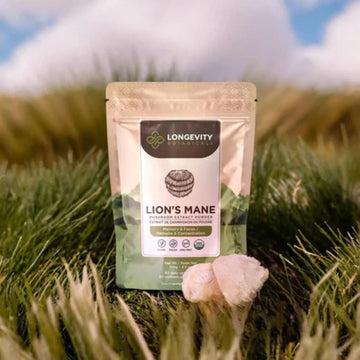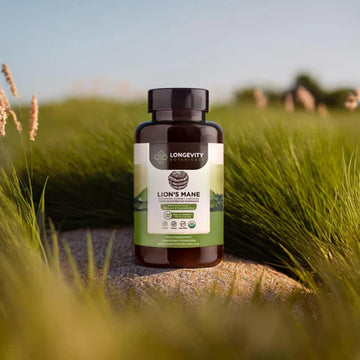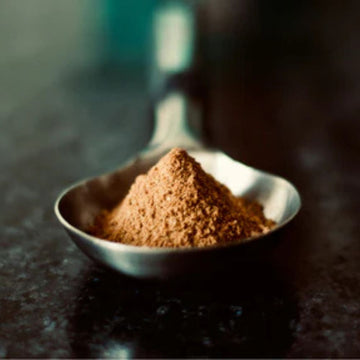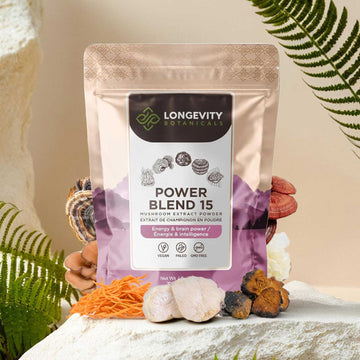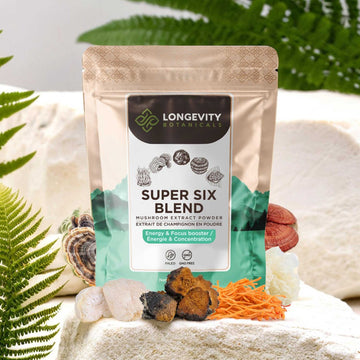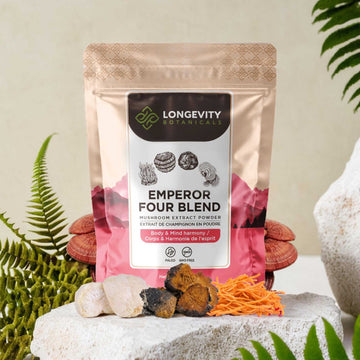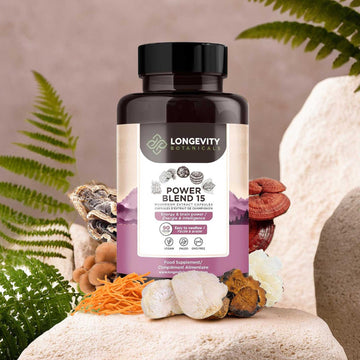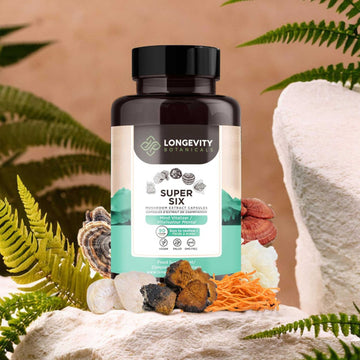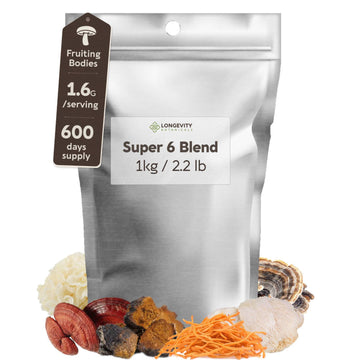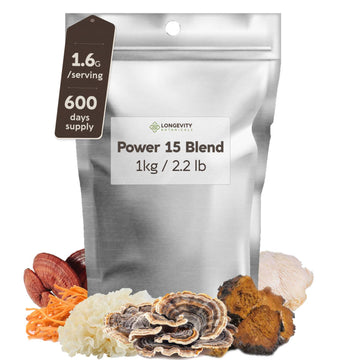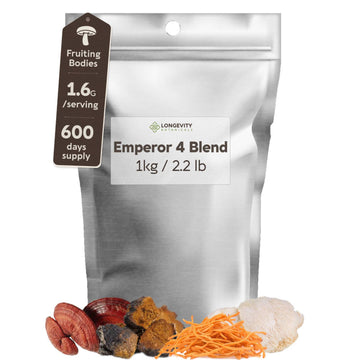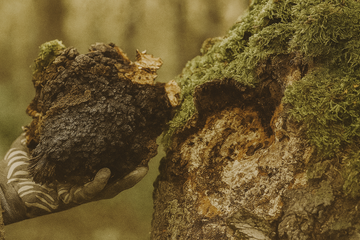Chaga is a dark, charcoal-like growth that forms on birch trees in cold climates. That deep color comes from melanin, a protective pigment that fungi build into their outer layer.
Melanin is not just a dye. In lab models it acts like a shield, soaking up energy, quenching free radicals, and binding certain metals. Chaga’s heavy melanin load is one reason it tests so high for antioxidant capacity in research settings.
What Chaga Melanin Is, in Simple Terms
Think “natural armor” for cells. Melanin is a network of ring-shaped molecules that can absorb light and neutralize reactive oxygen species. In Chaga, melanin sits in the black outer crust and in water-soluble complexes that tint hot-water extracts a tea-brown color. Lab analyses describe strong free radical scavenging from these melanin fractions, which helps explain the rich antioxidant signatures seen in Chaga extracts. Open-access study of Chaga melanins.
What the Strongest Evidence Shows
1) Protection of human DNA against oxidative stress. In a human cell model, an aqueous Chaga extract reduced hydrogen peroxide-induced DNA damage in lymphocytes, measured by the comet assay. This points to a direct antioxidant effect at the DNA level in vitro. See the PubMed record.
2) Help for skin cells under UV exposure. A recent review notes that Chaga-containing preparations reduced UV-induced DNA damage and inflammatory signals in keratinocytes, which are the main cells of the outer skin layer. The proposed drivers include melanin, polyphenols, and antioxidant enzymes present in the extract. Frontiers Pharmacology review.
3) Melanin itself carries antioxidant activity. Isolated Chaga melanins show high scavenging of free radicals and related bifidogenic effects in vitro, adding weight to the idea that the pigment is a key contributor to Chaga’s antioxidant profile. Details in Biomolecules.
What this means for you. These are lab and cell findings, not disease claims. They suggest that melanin-rich Chaga extracts can help neutralize common oxidative stressors and support DNA integrity in experimental systems. The clearest signals appear in models of hydrogen peroxide stress and UV challenge.
How Chaga Melanin Works
Free radical “sink”. Melanin’s ring structures can accept and donate electrons. This lets the pigment soak up reactive oxygen species before they strike lipids, proteins, or DNA. In simple language, melanin behaves like a sponge for oxidative sparks generated by sunlight, pollution, or heavy exercise.
Light energy absorber. Melanin absorbs a broad range of wavelengths. In skin models this helps reduce UV penetration, which lowers the formation of DNA lesions. When Chaga extracts tint water a deep brown, that is a visual hint of this energy-absorbing capacity referenced in the dermatology literature.
Metal binding. Melanin can chelate certain transition metals. Since free iron and copper can drive damaging Fenton chemistry, binding them reduces the fuel for harmful radicals. This is one way melanin helps keep oxidative reactions in check.
Antioxidants vs DNA Damage, a Quick Primer
Oxidation happens constantly. Our cells use oxygen to make energy, and this creates reactive byproducts. Sunlight, smoke, and metabolic stress add more. If these byproducts hit DNA, they can create strand breaks and base modifications.
Antioxidants limit the chain reaction. Molecules like melanin, polyphenols, and certain enzymes can blunt or repair that damage. In the Chaga story, melanin appears to be a primary first-line filter, then polyphenols and enzymes add support. The lymphocyte and keratinocyte data above match this model in simple systems. Human lymphocyte study.
How to Use Chaga Safely and Effectively
Choose a real mushroom extract. Look for fruiting-body material, not mycelium grown on grain, to avoid starchy fillers and to capture the natural pigment and phenolic spectrum. For a clear primer on this distinction, see our guide on fruiting body vs mycelium.
Prefer hot-water extraction. Chaga’s key water-soluble components, including melanin complexes and polysaccharides, come out with properly controlled hot-water extraction. Our bio-enhanced approach uses optimized temperature and time, and may include steps that help break chitin for better yield and solubility.
Serving ideas. A practical starting point is 500 to 1000 milligrams of a 10 to 1 extract once daily, taken with morning or midday fluids. A 10 to 1 ratio means 500 milligrams of extract contains the soluble actives from about 5 grams of raw material. Consistency over weeks matters more than exact timing.
Format options. If you like a neutral, tea-like taste, powders mix easily into hot water or coffee. If you want grab-and-go simplicity, capsules are convenient when available. For kitchen inspiration, explore how to use Chaga mushroom powder.
Quality Checklist, What to Look For
Fruiting body on label. This signals real mushroom tissue instead of grain-based mycelium. It correlates with richer beta-glucan and phenolic profiles that drive antioxidant effects.
Transparent specs and testing. Our Chaga is a 10 to 1 bio-enhanced hot-water extract, produced from wood-grown material, with typical beta-D-glucan content around 10 percent, and it is offered as a 100 gram powder. Batches are tested for identity and contaminants.
Simple, single-ingredient formulas. Melanin is abundant in Chaga. You should not need stimulants or sweeteners to feel that calm, steady antioxidant support in your daily routine.
Learn more and shop. If you are building a skin and antioxidant routine, our Chaga powder 100 g is a clean, melanin-rich option. For topical-adjacent education, see our article on Chaga mushroom benefits for skin.
Who Should Be Careful
Allergies and medications. If you have a known mushroom allergy, or if you take medications that affect blood sugar or blood clotting, speak with your clinician first.
Kidney and oxalate considerations. Chaga can contain oxalates. People with a history of kidney stones should get advice from a healthcare professional and use conservative servings.
Pregnancy and nursing. Safety data are limited. If you are pregnant or breastfeeding, consult your clinician before use.
Practical Takeaways
Melanin is a big part of Chaga’s antioxidant story. Isolated Chaga melanins and melanin-rich extracts show strong radical scavenging in test systems. Biomolecules paper.
DNA support is seen in lab models. A water extract protected human lymphocyte DNA from oxidative stress in vitro, and keratinocyte models under UV showed reduced DNA damage with Chaga-containing preparations. Human lymphocyte study. Frontiers review.
Quality and consistency matter. Choose fruiting-body extracts, verified specs, and clean hot-water processing, then use daily for several weeks to build steady antioxidant coverage.
References
Burmasova M A et al., Melanins of Inonotus obliquus, antioxidant and bifidogenic properties, Biomolecules 2019. Open access.
Park Y K et al., Chaga mushroom extract inhibits oxidative DNA damage in human lymphocytes, BioFactors 2004. PubMed.
Fordjour E et al., Chaga mushroom, a super-fungus with countless facets, Frontiers in Pharmacology 2023. Frontiers.
Educational only. This article does not diagnose, treat, or prevent disease. Talk with your healthcare professional before using any supplement, especially if you are pregnant, nursing, managing a condition, or taking medication.
